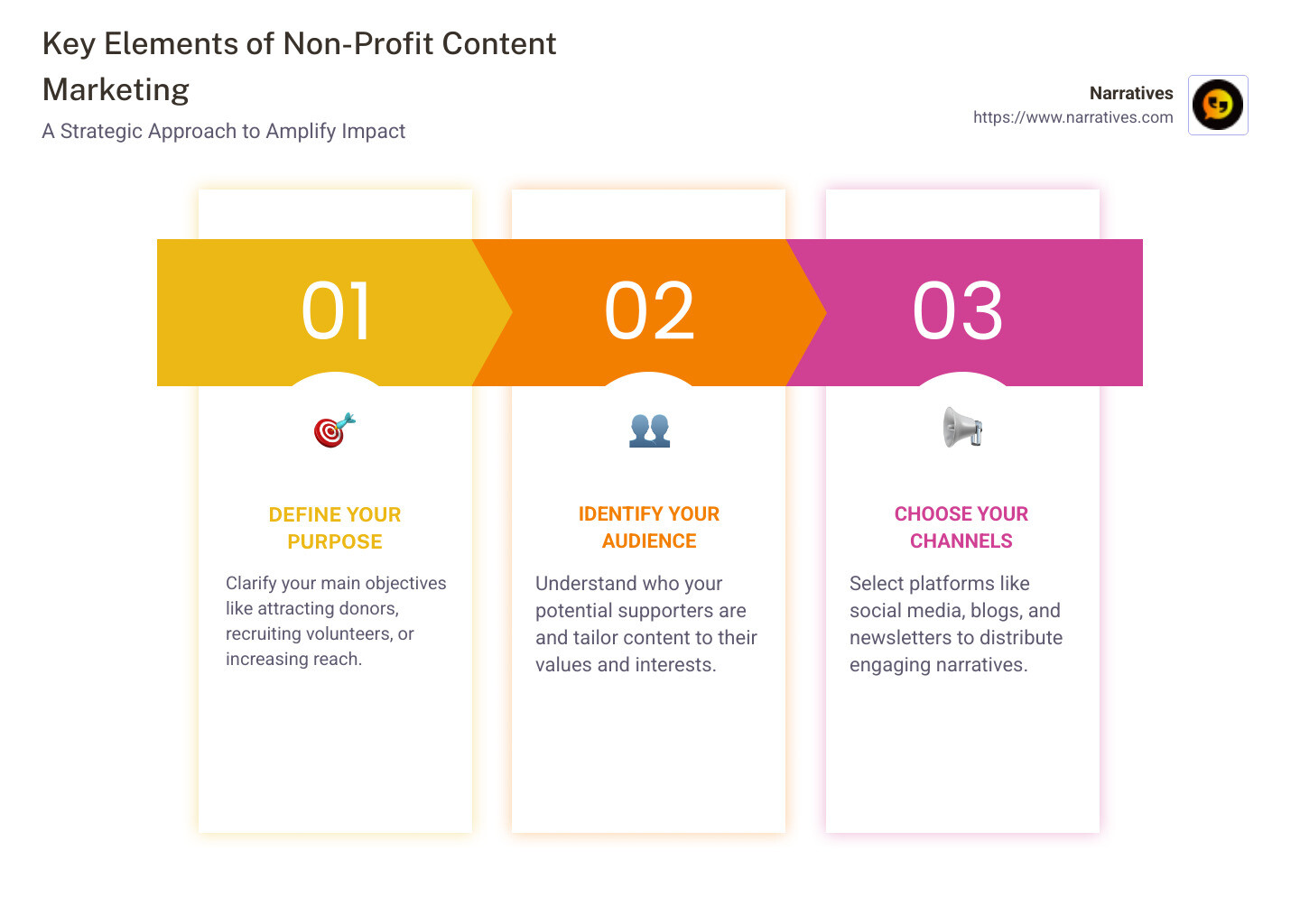From Cause to Content: Mastering Non-Profit Marketing

Content marketing for non-profits is more than a trend—it’s a game-changer for any organization aiming to amplify its impact. Whether your goal is to raise awareness, increase donations, or drive volunteer engagement, content marketing provides the tools and strategies necessary to effectively communicate your mission and inspire action. Here's a quick overview of what content marketing for non-profits involves:
- Define Your Purpose: What is the main objective of your content? Whether it’s attracting donors, recruiting volunteers, or simply broadening your reach, clarifying your goals will shape your strategy.
- Identify Your Audience: Understanding who your potential supporters are will help you tailor content that speaks directly to their interests and values.
- Choose Your Channels: Social media, blogs, newsletters, and videos are just a few of the platforms where you can distribute your engaging narratives.
- Plan and Measure: Establish a strategic plan and measure your efforts to ensure that your content is driving the intended results.
This introduction is designed to give non-profit leaders, communications experts, and social impact organizations a clear understanding of the foundational elements of content marketing. By focusing on storytelling and authentic engagement, non-profits can not only resonate more effectively with their audience but also drive meaningful change.

Understanding Content Marketing for Non-Profits
Content marketing for non-profits is a strategic approach focused on creating and distributing valuable, relevant, and consistent content to attract and retain a clearly defined audience. Unlike traditional marketing, which often revolves around selling products or services, non-profit content marketing is mission-driven. This means every piece of content should align with the organization's overarching goals and values.
Mission-Driven Approach
At the heart of content marketing for non-profits is the mission. Non-profits aren't just selling a product; they are advocating for a cause. This mission-driven approach enables organizations to create content that not only informs but also inspires action. For instance, a non-profit focused on environmental conservation might produce a series of blog posts detailing the impact of deforestation, paired with actionable steps readers can take to help.
Building Emotional Connections
Emotional connection is a powerful tool in content marketing. By telling compelling stories, non-profits can evoke emotions that motivate people to engage, donate, or volunteer. A well-crafted story about a family benefiting from a non-profit's services can make the cause more relatable and urgent to potential supporters.
The Role of Storytelling
Storytelling is central to non-profit content marketing. It helps humanize the cause and makes it more relatable. For example, a non-profit working with homeless individuals might share personal stories of change, highlighting how donations have made a difference. This not only educates the audience but also builds trust and credibility.
In summary, content marketing for non-profits is about more than just spreading information. It's about creating a connection between the audience and the cause, driven by the organization's mission and improved by emotional storytelling. This approach not only helps in achieving immediate goals like fundraising but also fosters long-term relationships with supporters.
Building a Non-Profit Content Marketing Strategy
Creating a successful content marketing for non-profits strategy is like building a strong foundation for a house. You need clear goals, a good understanding of your audience, and the right channels to reach them. Here's how to get started:
SMART Goals
First, set SMART goals—Specific, Measurable, Achievable, Relevant, and Time-bound. These goals help you track progress and make adjustments when necessary.
For example, instead of saying "increase donations," a SMART goal would be "increase online donations by 20% in the next six months." This sets a clear target and timeframe, making it easier to measure success.
Audience Segmentation
Understanding your audience is crucial. Not everyone will connect with your message in the same way. Audience segmentation involves dividing your audience into smaller groups based on shared characteristics like age, location, or interests.
To do this, start by conducting surveys or analyzing your social media interactions. For instance, if you notice that young adults engage more with your Instagram posts, tailor content specifically for them on that platform.
Regularly update your audience profiles to keep your content relevant and engaging. This ensures that your message resonates with the right people, maximizing your impact.
Promotional Channels
Choosing the right promotional channels is key to reaching your audience effectively. Focus on platforms where your audience is most active. This could be social media, email newsletters, or blogs.
For instance, if you're targeting a younger demographic, platforms like Instagram and TikTok might be more effective. Schedule posts when your audience is most active to boost visibility and engagement.
Adapt your strategy based on feedback and engagement metrics. This helps you stay relevant and effective in your communications.
In summary, a well-crafted content marketing strategy for non-profits starts with setting clear goals, understanding your audience, and choosing the right channels. These steps ensure that your content not only informs but also inspires action towards your mission.
Next, we'll explore the different types of content that can help non-profits connect with their audience and achieve their goals.
Types of Content for Non-Profits
When it comes to content marketing for non-profits, the type of content you create can make a significant difference in engaging and inspiring your audience. Let's explore three powerful content types: storytelling, educational content, and engagement-driven media.
Storytelling
Storytelling is the heart of non-profit content. It’s about connecting emotionally with your audience and showing the real-world impact of your mission. A compelling story can transform a passive reader into an active supporter.
Consider the example of Doctors Without Borders, which often shares case studies detailing their medical interventions in crisis zones. These stories not only highlight the organization's work but also vividly illustrate the direct benefits of donor contributions.
To craft a powerful story, focus on:
- Real People: Share stories of individuals who have benefited from your work.
- Emotional Impact: Use narratives that evoke feelings and inspire action.
- Clear Call to Action: Encourage readers to support your cause through donations or volunteering.
Educational Content
Educational content helps inform your audience about the issues you address and the solutions you offer. This type of content positions your organization as a knowledgeable leader in your field.
For instance, the Alzheimer’s Association offers on-demand webinars and training sessions to educate families and caregivers about Alzheimer’s disease. These resources are vital for spreading knowledge and effectively supporting their community.
To create effective educational content:
- Use Simple Language: Make complex topics easy to understand.
- Incorporate Visuals: Use infographics or videos for better engagement.
- Provide Value: Ensure the content is useful and relevant to your audience.
Engagement-Driven Media
Engagement-driven media includes content that encourages interaction and participation from your audience. This could be through social media posts, polls, or interactive stories.
For example, the World Wildlife Fund (WWF) uses infographics to communicate the importance of conservation efforts. These visually engaging materials are shared across social media platforms, encouraging users to interact and share.
To boost engagement:
- Be Interactive: Create content that invites comments, shares, or likes.
- Use Humor: Light-hearted content can make your message more relatable.
- Leverage Trends: Tie your content to current events or trending topics to increase visibility.
Incorporating these content types into your strategy will not only improve your content marketing for non-profits but also deepen the connection with your audience. By telling stories, educating, and engaging, you can inspire action and drive meaningful change.
Next, we'll dive into the top 5 content formats that can further amplify your non-profit's message and impact.
Top 5 Content Formats for Non-Profits
When diving into content marketing for non-profits, selecting the right content formats can amplify your message and boost engagement. Here are the top five formats that have proven effective for non-profits:
Blogs
Blogs are a cornerstone of content marketing, offering a platform to share in-depth stories and updates. Regular blog posts can keep your audience informed and engaged with your mission.
- Storytelling: Share success stories or project updates, much like Charity: Water does, connecting donors with the impact of their contributions.
- Educational Posts: Explain your work and its importance, helping readers understand complex issues.
- SEO Benefits: Well-written blogs can improve your website's search engine ranking, attracting more visitors.
Infographics
Infographics turn complex data into visually appealing and easy-to-digest content. They are particularly effective in illustrating statistics and impacts.
- Visual Appeal: Use tools like Canva or Adobe Illustrator to create engaging visuals.
- Shareability: Infographics are highly shareable across social media, increasing your reach.
- Example: The World Wildlife Fund (WWF) effectively uses infographics to highlight conservation efforts.
Case Studies
Case Studies provide detailed insights into your organization's impact, showcasing real-world examples of your work.
- Credibility: They build trust by demonstrating successful outcomes, like those shared by Doctors Without Borders.
- Detailed Narratives: Use interviews and data to create compelling before-and-after scenarios.
- Donor Engagement: Showcasing tangible results can motivate donors to continue supporting your cause.
Videos
Videos are a dynamic way to tell stories and connect emotionally with your audience.
- Emotional Connection: Videos can bring your mission to life, making it relatable and compelling.
- Versatility: From documentaries to quick updates, videos can cover a range of topics.
- Distribution: Share across social media, embed in emails, or host on your website, like Charity: Water does on their YouTube channel.
Newsletters
Newsletters keep your supporters informed and engaged with regular updates.
- Regular Communication: Keep your audience updated on your latest projects and achievements.
- Personal Touch: Use newsletters to thank donors and highlight volunteer efforts.
- Call to Action: Encourage further engagement, whether it's volunteering, donating, or sharing your content.
Incorporating these content formats into your strategy can significantly improve your content marketing for non-profits. Each format offers unique ways to engage your audience, tell your story, and drive action.
Next, we’ll explore how to measure success in your content marketing efforts, ensuring you can track progress and make informed improvements.
Measuring Success in Content Marketing for Non-Profits
Measuring success in content marketing for non-profits is crucial to understanding what works and what doesn't. Here's how you can evaluate your efforts effectively:
Key Metrics
Tracking the right metrics is essential. Focus on these key performance indicators (KPIs) to gauge your content's impact:
- Engagement Rates: Measure likes, shares, comments, and other interactions on social media posts and blog articles.
- Website Traffic: Use tools like Google Analytics to monitor page views, unique visitors, and the average time spent on your site.
- Conversion Rates: Track how many visitors take desired actions, such as signing up for newsletters or making donations.
- Content Downloads: If you offer e-books or white papers, count the number of downloads to assess interest.
Analytics Tools
Leverage analytics tools to gain deeper insights into your content's performance:
- Google Analytics: Provides comprehensive data on website traffic and user behavior.
- Social Media Insights: Platforms like Facebook and Instagram offer built-in analytics to track engagement and reach.
- Email Marketing Platforms: Tools like Mailchimp provide metrics on open rates, click-through rates, and subscriber growth.
Performance Evaluation
Regularly evaluate your content marketing efforts to refine your strategy:
- OKR Dashboards: Create an Objectives and Key Results (OKR) dashboard to track progress toward your goals. Update it consistently to reflect real-time data.
- Content Marketing Success Spreadsheet: Use a simple spreadsheet to compare year-over-year growth in website visitors, subscribers, and social media followers.
- Feedback Loops: Gather feedback from your audience through surveys or direct communication to understand their preferences and improve content accordingly.
By focusing on these metrics and tools, you can effectively measure the success of your content marketing for non-profits. This approach allows you to identify what's working, adjust your strategy as needed, and ensure that your content continues to engage and inspire your audience.
Next, we'll tackle some frequently asked questions about content marketing, providing clarity on common concerns and strategies.
Frequently Asked Questions about Content Marketing for Non-Profits
What is content marketing for non-profits?
Content marketing for non-profits is a strategic approach to creating and sharing content that informs, inspires, and engages. Unlike traditional marketing, it focuses on aligning with the audience's values to build deep emotional connections. The goal isn't just to raise funds but to foster long-term support and involvement. By sharing stories of impact, educational articles, and engagement-driven media, non-profits can effectively communicate their mission and motivate action.
How can non-profits leverage social media?
Social media is a powerful tool for non-profits to connect with their audience. Here are some ways to make the most of it:
Build Relationships: Use platforms like Facebook and Instagram to engage with supporters. Share updates, success stories, and behind-the-scenes content to create a sense of community.
Post Regularly: Consistency is key. Post updates, events, and calls to action to keep your audience engaged and informed.
Use Visuals: Photos and videos can significantly boost engagement. Share compelling images and short clips that highlight your non-profit's impact.
Encourage Interaction: Ask questions, host live discussions, and encourage followers to share their experiences related to your cause.
Leverage Hashtags: Use relevant hashtags to increase your content's visibility and reach new audiences interested in your mission.
Why is storytelling important for non-profits?
Storytelling is at the heart of effective content marketing for non-profits. Here's why it's essential:
Emotional Connection: Stories evoke emotions and make your cause relatable. They help supporters see the real-world impact of their contributions.
Memorable Messaging: A well-told story is more memorable than facts and figures alone. It helps your message stick with your audience.
Inspiring Action: Stories motivate people to take action, whether it's donating, volunteering, or sharing your message with others.
Building Trust: Sharing real stories of success and challenges builds transparency and trust with your audience, strengthening their commitment to your cause.
By integrating storytelling into your content strategy, you can create a powerful narrative that resonates with your audience and drives meaningful engagement.
Next, we'll conclude with insights into how Narratives and digital storytelling can amplify community impact.
Conclusion
In the changing landscape of content marketing for non-profits, Narratives stands out as a guide for organizations aiming to amplify their community impact through digital storytelling. Our mission is to lift underrepresented voices by crafting high-quality, emotionally resonant multimedia content. This approach not only inspires action but also builds trust and increases visibility for non-profits.
Digital storytelling is more than just a buzzword—it's a powerful tool that transforms how non-profits communicate their mission. By focusing on authentic stories, we help organizations connect deeply with their audience. This connection fosters a sense of community and drives engagement, encouraging supporters to become active participants in the cause.
Our strategy is simple: partner with non-profits to create content that resonates. Through video, infographics, blogs, and more, we showcase the real-world impact of their work. This approach not only improves their message but also positions them as leaders in their field.
At Narratives, we believe that every story has the power to change the world. By using the potential of digital storytelling, non-profits can reach new heights in their marketing efforts, creating lasting change in their communities.
Explore how Narratives can help your organization tell its story and make a greater impact. Learn more about our services.


